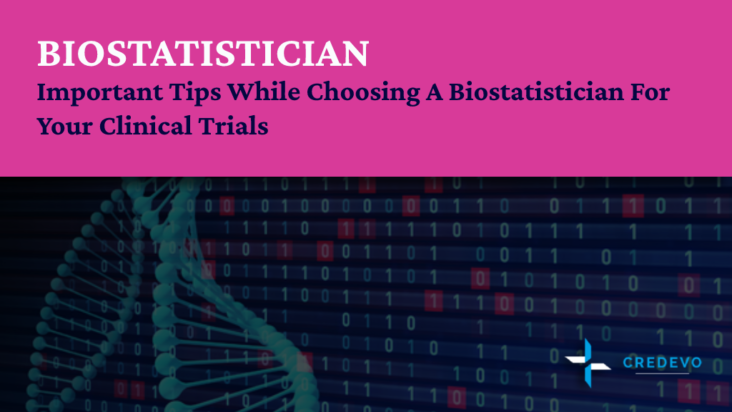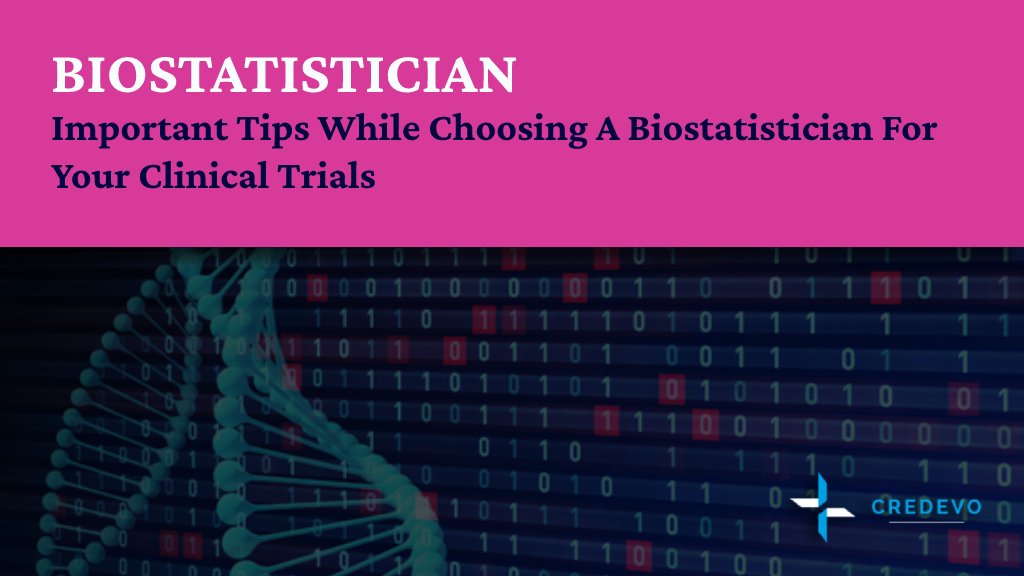Important Tips While Choosing A Biostatistician For Your Clinical Trials?

Clinical Biostatistician and biostatistics are crucial for clinical trials and team members because they are path deciders for finding clinical trial end-points. For instance, it is essential to understand how to derive the components used in the analysis and assumption of the resulting data.

The statistician’s role is critical from the start to ensure that the data make sense in terms of clinical significance rather than statistical significance. It helps in reducing the likelihood that important clinical trial-related questions won’t be able to be resolved through data analysis.
Biostatisticians consider the safety, effectiveness, and comparative performance of medical equipment and drugs. They collaborate with clinicians and therapy experts to design unbiased studies that meet research objectives.
Who is a biostatistician?
A biostatistician is a person who uses statistical and mathematical techniques to address issues in domains including biology, medicine, and public health. In other words, using quantitative analysis, biostatisticians assist the medical industry in making data-driven judgments. A biostatistician frequently ensures the validity of the statistical design of the study, analysis of the day, and presentation of the results.
Numerous related professions surround the biostatistician, such as epidemiologists, medical informaticians, and bioinformaticians.
Roles & importance of biostatistician
The creation of protocols
The following are the roles and responsibilities of the biostatistician when creating clinical research protocols.
Objectives
Biostatisticians must specify the hypothesis to be tested based on the purpose of the scientific paper. In other words, they have to meet the test criteria. They are also responsible for selecting and defining endpoints in clinical research.
Study design
The biostatistician’s study design selection should provide the data required to achieve the following objectives.
- Defining strategies to lessen selection bias.
- Define the randomization processes, such as
- Establishing a sequence
- allocation concealment
- length of follow-up
- contact frequency in the context of a randomized controlled trial.
Sample size
Demonstrating the accuracy or reliability of endpoints: The methods used to choose the sample size must be consistent with the primary method of data analysis and appropriate for the design.
Completed analysis strategy
The plan summary aims to support the data collection and design methods employed and to confirm that you can achieve the goals by providing a statistical method for evaluating the primary intentions, testing methods, and hypotheses.
Review of the protocol
The Lead Study Biostatistician (LSB) should follow the entire protocol to confirm that the following is accurate.
- Clarity completeness
- Consistency
- Quality of data issues
- Feasibility
Writing the protocol
It involves using the objectives, outcomes, study design, and allocation concealment as inputs to determine the sample size, randomization processes, and analytic plan.
Management of data
- Managing CRFs with design and content
- Dataset validation with error checking specification and test data
- CRF annotation
- record layout
Implementing the study
It involves choosing a sample size and using randomization techniques.
Study supervision
It entails quality, safety, and effectiveness monitoring.
Data evaluation
A written analysis plan that details the analysis hierarchy and all the hypotheses to be tested is helpful for reporting, manuscript preparation, and ensuring the accuracy and validity of the results.
Writing reports or manuscripts
Data description including statistical approach, method section, endpoints, and design.
Data is present in tables, graphs, and other visual formats in the results section.
The discussion portion includes the results’ proper interpretation.
How and when to talk to a statistician?
To develop testable hypotheses and prevent potential biases in the study design, early-career researchers must consult a statistician in the planning process of a clinical study. Clinical researchers should also seek advice from statisticians early in their careers.
A person can discover statisticians by taking statistics courses, taking part in a sizable study, going to the statistical department of an academic or research institution, contacting statisticians who are engaged in their clinical mentor’s research, or just by word of mouth.
Another association available to clinical researchers is the statistical advisors of the American Statistical Association. We could assist them by using interactive websites that perform statistical calculations, like power calculations.
Due to the need to justify the study sample size, determine clinical significance, and specify stopping rules for a trial, the National Institutes of Health requires research teams to include a biostatistician before obtaining grant funding for any clinical trials.
Significant concerns while choosing a biostatistician for your clinical trials
Make sure biostatisticians have the following abilities before you recruit them for your clinical trial:
- Ability to analyze statistics.
- It’s crucial to understand measuring scales because the choice of the proper statistical analysis depends on the ability to specify the correct type of variable to be examined.
- Knows ISO 13485, CE, and FDA regulations, experience assisting with regulatory filings and statistical concerns.
- Knowledge of South American, Chinese, and Indian regulatory protocols is advantageous.
- Test strip performance monitoring and product batch release.
- Knowledge of various techniques, drug indications, experiment design and analysis, and experience with DV and clinical investigations supporting the development of new products.
- Find missing, inconsistent, outlier, and unexpectedly low variability and deviation in the protocol data.
- Transform data, estimate, calculate confidence intervals, test a hypothesis, and alter significance and confidence intervals.
- Analyze the consistency, range, and data variability of data trends within and between sites.
- Construction of the Statistical Analysis Plan (SAP), dummy tables, and the list of tables (LoT);
- Instruct programmers and verify TLDs.
- Compare treatments using ITT analysis, multiple primary variables, treatment through center interaction, dosage response analysis, and size effect (e.g., Dunnett’s, Bonferroni Correction, closed test methods, and single primary treatment comparison).
- Evaluate and report on-site or across-site data-gathering errors that are serious or systematic. Report any issues with data integrity or possible data manipulation.
- Examine site attributes and performance indicators.
- The interim analysis compares the effectiveness or safety of the various treatment options.
- Create a statistical analysis strategy that includes a technical and in-depth explanation of the key aspects listed in the protocol.
- Knowledge of popular statistical analysis software (SAS, R, AMOS, Eviews, Strata, etc.).
- The ability to respond to regulators’ requests and inquiries.
Conclusion
The job of a biostatistician involves much more than just data analysis after a clinical study. The to-do list for biostatisticians managing clinical trials is extensive.
- They guide enrollment patients fairly and randomly to select the appropriate sample size and study design.
- They contribute to endpoint definition, creating definitions for data analysis, and producing tables and graphics for the clinical research report.
Before choosing the best biostatistician for your clinical trial, you should consider several factors.
Do You Have Any Questions About Choosing The Best Biostatistician For Your Clinical Trials?
Are you seeking the best biostatistical services or any other support for your clinical trials? Please provide your specific requirements below to connect with us and explore our expert services.